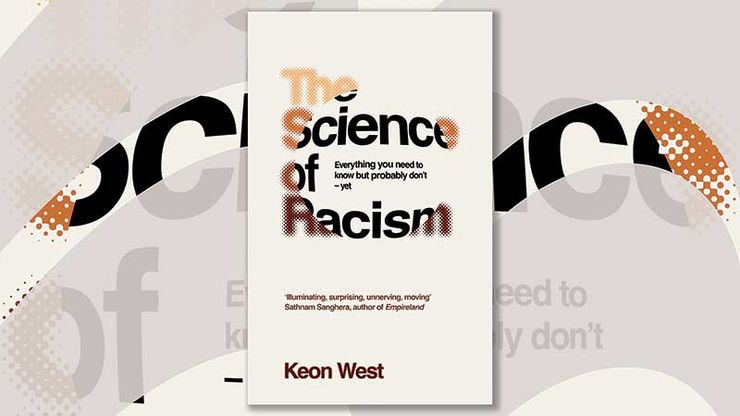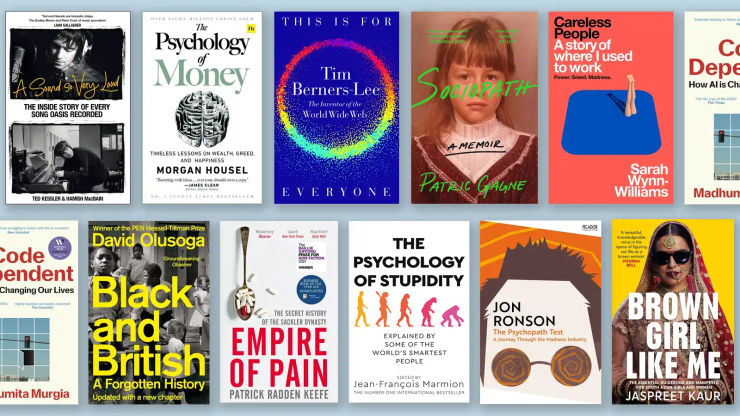5 facts about racism you need to know (and the science behind them)
The eye-opening scientific studies that highlight the reality of racism and explain how scientists know it’s still a serious problem.

In his book, The Science of Racism, Keon West uses clear scientific research to expose what we know about racism, exactly how we know it, and what we can do about it. Here, he introduces some of the findings, and the research behind them.
In a 2019 study, researchers West and Eaton asked 148 people to judge how racist they were compared to both people in the wider society and to other people in the room with them at the time. Regardless of their point of comparison, 100% of the participants believed that they were less racist than the average person.
You also probably believe that you are less racist than the average person. The available research indicates that almost everybody does. Half of us, however, are wrong.
We live in a polarized world, a world of proliferating DEI (diversity, equity, and inclusion) initiatives that co-exist with an anti-DEI backlash; of increasing immigration (e.g., in both the UK and the US) and far-right anti-immigration riots; of the first Black women to lead major political parties on both sides of the Atlantic, and of increasing wealth gaps between White and ethnic minority families. Behind all these contrasts lurks racism and the difficult (but necessary) conversations about what it is, what it isn’t, and what we can know about it. Everyone, it seems, has an opinion.
‘Behind all these contrasts in our society lurks racism and the difficult (but necessary) conversations about what it is, what it isn’t, and what we can know about it. Everyone, it seems, has an opinion.’
In The Science of Racism, I ask readers to take nothing on faith; racism shouldn’t be discussed primarily in terms of what we think or feel. Rather, it’s about what we know. This book fully describes what we know based on rigorous scientific research, and clearly cites the date of each study and the names of the authors, ensuring that anyone can verify the information for themselves.
Here are five startling facts about racism and the science that shows how real and powerful it still is.
1. Even when they apply to exactly the same jobs with exactly the same qualifications and experience, White people are much more likely to get callbacks and job offers than ethnic minorities are.
In 2009, Pager, Western and Bonokowski hired Black, White, and Latino testers to apply for 340 real jobs in New York City. Their CVs were matched so that their education, achievements, and experience were identical. The testers themselves were matched in terms of verbal skills, interactional styles and physical attractiveness. Still, despite identical qualifications and presentation styles, Black applicants had a 15.2% callback rate, Latino applicants had a 25.1% callback rate, and White applicants had a 31% callback rate – over twice as high as the Black applicants.
In 2012, Booth, Leigh and Varganova applied for over 4,000 jobs in Australia. They used a set of CVs that were identical except for the ethnicity of the person supposedly applying for the job. Despite otherwise identical CVs, the Black (i.e., Indigenous) applicants had a 26% callback rate and the White applicants had a 35% callback rate.
In 2019, Di Stasio and Heath applied for approximately 3,200 jobs in the United Kingdom using CVs that were identical except for the name of the person who was ostensibly applying for the post. They found that applicants with Black-sounding names had a 12.3% callback rate, while people with White British-sounding names had a much more successful 24.1% callback rate.
2. Even when they behave in exactly the same way, White students are assumed to be better behaved, more accomplished and more worthy of support than ethnic minorities are.
In 2009, Burgess and Greaves compared over two million British students’ internal evaluations (i.e., done by their teachers at school) and external evaluations (i.e., done by external assessors who never met the children), to see which children were most likely to be underestimated by their teachers. Ethnic minority children were much more likely to be scholastically underestimated. For example, just looking at their English scores, only 12.4% of White students were underestimated by their teachers, a number that jumped to 17.2% for Black Caribbean children, 18.3% for Black African children, and 20.2% for Pakistani children.
In 2015, Milkman and colleagues sent over 6,500 emails to professors at top universities, pretending to be hopeful PhD candidates. Though the messages were identical except for the apparent gender and ethnicity of the PhD applicants, women and ethnic minorities were overall 40% more likely to be ignored than White male students.
In 2016, Gilliam and colleagues asked 135 teachers to look out for 'challenging behaviour' in the classroom. Even though all of the children they observed behaved the same way, and even though none of the children were behaving badly, the teachers spent significantly more time looking at and anticipating 'challenging behaviour' from the Black children than from the White children.
3. Even when they do exactly the same things, Ethnic minorities are interpreted as guiltier, more dangerous, and more criminal than White people.
In 2009, Schreer and colleagues sent Black and White ‘shoppers’ (who dressed and behaved in similar ways) to high-end stores to see how they were treated by the retail staff. Despite behaving the same way, Black shoppers were significantly more likely to be stared at (Black men - 100%; Black women - 40%), than White shoppers were (White men - 50%; White women - 25%). Black shoppers were also significantly more likely to be followed around the store (Black men - 60%; Black women - 20%), than White shoppers were (White men - 50%; White women - 0%). White women in particular were never followed around the store.
In 2017, West and Lloyd showed 120 British people various versions of newspaper reports about violent crimes. Though the crimes described were always exactly the same, the participants were sometimes told that they were committed by a Muslim perpetrator and sometimes told that they were committed by a White, non-Muslim perpetrator. The participants perceived the crimes as 10% to 20% worse, and as 29% to 74% more like “terrorism” if they were committed by a Muslim.
In 2019, Howard asked 121 participants to read two versions of a newspaper article about an individual who had been wrongfully convicted of a crime following a false confession, but was later exonerated. Despite the stories being otherwise identical, the participants in the study perceived the Black exoneree to be 60% more aggressive, 20% less deserving of government assistance and 80% more likely to commit a crime upon release than the White exoneree.
3b. Even when they have no criminal history at all, ethnic minorities are treated worse than White people who do have criminal records.
In 2003, Pager hired identically qualified White and Black researchers matched on appearance and self-presentation. They applied for 350 jobs while presenting themselves either as having a criminal record (half of the time) or as not having a criminal record (the other half of the time). In this study even White applicants with criminal records got a higher proportion of callbacks (17%) than identically qualified Black applicants who did not have criminal records (14%).
4. Even when offering exactly the same goods or services, White people are perceived as more competent, legitimate, and valuable than ethnic minorities.
In 2010, Bavishi and colleagues showed 375 future university students the CVs of some of their potential future professors. The CVs were all equivalent except for the apparent gender and ethnicity of the professors presented. The results showed that the students judged the supposedly Black professors as about 10% less legitimate and lower in interpersonal skills than the identically qualified White professors.
In 2011, Ayres and Banaji posted baseball cards for sale on eBay. Though they always posted exactly the same cards for sale, the accompanying picture either showed the cards being held by a light-skinned (apparently White) hand or a dark-skinned (apparently Black) hand. The cards sold for about 20% less if they were being sold by Black people instead of White people.
In 2019, Underhill wanted to know if financial incentives (i.e., money) could motivate people to behave kindly towards others. She offered 1,389 participants a variety of incentives (ranging from no money to $50,000) to encourage them to donate a kidney to a hypothetical patient (who was either White or Black). Underhill found that money did significantly motivate people to donate a kidney. However, she also found that, for the same financial incentive, people were 13% less willing to donate a kidney to a Black patient than to a White one.
5. Many people openly and explicitly prefer White people as romantic partners compared to ethnic minorities.
In 2014, Mendelsohn, Taylor, Fiore and Cheshire analysed the personal profiles and communication records of over a million users of an online dating site. Compared to Black women, White women were 1.3 times more likely to say that they were only interested in dating people of their own race. Compared to Black men, White men were 2.5 times more likely to say that they were only interested in dating people of their own race. In the same 2014 study, Mendelsohn and colleagues found that Black people were more than ten times as likely to contact a White person as White people were to contact a Black person.
In 2020, West asked 3,453 White British participants how likely they would be to enter a romantic relationship with a White, Black, East Asian or South Asian partner. No deception at all was used in this study. Still, on average, the participants reported being significantly more likely to enter a relationship with a White partner than with a Black partner (58% more likely), an East Asian partner (66% more likely) or a South Asian partner (77% more likely).
There are thousands of other, similar studies proving that ethnic minorities are treated unfairly in love and friendship, in childhood as well as adulthood, in the workplace, in the media, by the healthcare, policing, and justice systems, in voting booths and at the wrong end of a gun. Fortunately, there are also thousands of studies showing that we know how to reduce racism and how to manage its negative effects.
Want to know more?
The Science of Racism
by Keon West
'Illuminating, surprising, unnerving, moving . . . and, sadly, utterly necessary' – Sathnam Sanghera, bestselling author of Empireland
In this groundbreaking book, Professor Keon West cuts through divisive anecdotes and rhetoric with decades’ worth of clear, factual, rigorous science – the data that reveals truths about racism that are shocking and tragic, but also (somehow) funny and entertaining. Whatever you think you know, and whatever you’ve read before, this book will ensure that you never see racism in the same way again.



